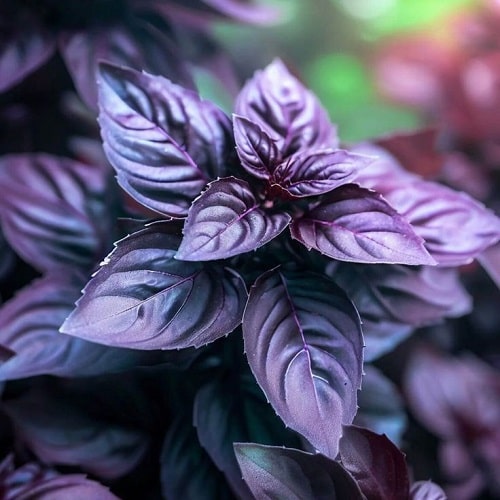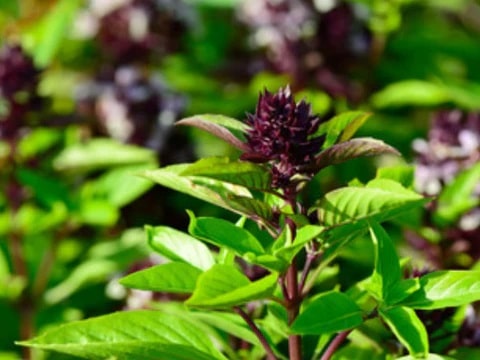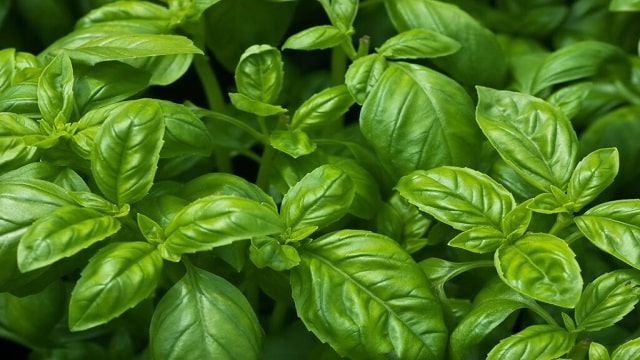Basil is one of the most commonly used aromatic plants in cooking. We will tell you what it is, where it comes from, as well as its benefits and contraindications when using it in your cooking recipes. In the Mediterranean, basil felt at home even though its origins are in Asia. Its varieties range from the bright green of the Genovese basil to the purple of the purple basil. And its benefits are still being investigated due to the prolific nature of its active biocompounds: it helps calm our nerves, it takes care of everything from the heart to the stomach and it likes to make life easier for people with diabetes while its penetrating aroma delights any chef. Any contraindications? It is possible if we use it excessively. Everything about it, its varieties, properties, and magnificent culinary uses, is below.
What is basil and what is it used for?
Basil ( Ocimum basilicum ) is an aromatic herb belonging to the Lamiaceae family, the same as mint. It is native to tropical areas of Africa and Southeast Asia. Its leaves are tender and have been used as a condiment for millennia around the world.
Although in our imagination it appears as a small plant on the kitchen counter, in reality it can reach up to 1.30 m in height. Its colour varies from green to deep purple, and in the last decade, its hydroponic version, grown without the need for soil, has spread among the most famous brands in the food industry.
Basil is commonly used as a dry condiment, although it can also be cooked or used in its unbeatable fresh version. Its potential is such that it can decorate and add freshness to tomato and mozzarella pizza, top caprese salad and be one of the essential ingredients of a good pesto, the sauce originating in the Liguria region made from basil, pine nuts, garlic, and parmesan cheese in olive oil. Beyond its penetrating aroma, basil calms the nerves, relieves stomach discomfort, and preserves our youthful body. What more could you ask for?
Origin and cultivation of basil
Basil is native to Asia Minor and Persia and grows in temperate and warm-temperate regions. It entered Europe through ancient trade routes, settling in the Mediterranean basin which, with an average temperature of 15°C to 25°C, became an ideal territory for its cultivation. Proof of this is its iconic use in Italian cuisine.
The etymology of basil is a linguistic and historical testimony. According to INECOL, the Mexican Institute of Ecology, the root of the scientific name Ocimum basilicum comes from the Greek ” okimon” and ” basilikon”, a term that designates majesty. And while its name in Italian, Basilico, and in French, basilic, reflects the connection with ancient Greece, in Spanish “albahaca”, derived from the classical Arabic halaqa, shows us the intimate connection with the al-Andalus of the Middle Ages.
When it comes to growing basil, it is important to know that this Lamiaceae is a natural enemy of frost, so it should not be exposed to temperatures below -2 °C. It can be grown in a nursery, in soil or hydroponically. In the first case, even February and March can be good times for sowing since it enjoys climatic protection. In any other case, the ideal months for sowing are April and May, taking into account the climate of the region and its optimum temperature of 20 °C with a preference for non-saline soils. After ten days we can enjoy the first shoots.
Types of basil
The most well-known variety of basil in the West is Genovese basil and to a lesser extent purple basil. In Asia, on the other hand, Thai basil and lemon basil are abundant, which can greatly enrich our recipe book when we learn to use them. There are other less abundant varieties such as alpine basil, which is able to withstand colder temperatures, or cinnamon. Below, we delve into the four varieties most present in our kitchens: Genovese basil, purple basil, Thai basil, and lemon basil.
Genovese Basil
Genoese basil is vigorous, deep green, and is considered easy to care for, as it requires little more than protection from the cold and good watering. It can be purchased quite easily and kept close to our stoves throughout the year. Its flavour is a sweet and penetrating combination and the recipe par excellence is Genoese pesto, a direct connection with Italy.
Purple Basil

Purple basil knows how to attract attention with its intense purple hue. Its leaves are as fleshy as green basil, and its aroma is citrusy. You can add a few leaves to a brothy fish or infuse it in water knowing that it offers a spicier flavor than Genovese basil.
Thai Basil

Thai basil has characteristic purple clusters at the tips of its stems that make it a real visual spectacle in the garden. Its leaves are green, oval, and fleshy and due to its wide distribution in Asia, it is preferred in the preparation of dishes such as Pad Kra Pao, Thai basil fried chicken, or basil rice.
Lemon Basil

Lemon basil is the most citrusy of all. As with the Thai variety, this variety is spread mainly in North Africa and South Asia where it is widely used for all kinds of sauces and dressings. For example, finely chopped, it can be incorporated in a balanced way on a base of melted butter and added to chicken or in a vinaigrette, together with oil, vinegar, and a pinch of syrup to give an extraordinary touch to our salads. Lemon basil has also dared to add freshness to desserts.
Properties and benefits of basil
Basil can help improve mood, reduce anxiety, improve cardiovascular health and, according to studies, can be an ally in cancer prevention. It also has a great contribution of antioxidants that help prolong the life of our cells.
Anti-hypertension and cardioprotective effect
Eugenol is a compound present in basil and found in high concentrations in the essential oil. This component has a vasodilatory function and is capable of mediating the prevention of platelet aggregation. In this way, its presence gives basil a cardioprotective activity and is an ally against hypertension.
Improvements on the respiratory system
Basil contains bronchodilators, vasodilators, and antimicrobial properties that make it effective for use against conditions such as asthma, bronchitis, and various respiratory infections. This makes it an ally of the respiratory system with possible uses from multiple perspectives.
Antidepressant, sedative, and anxiolytic capacity
Serotonin is a key neurotransmitter for a good mood. According to studies with animal models, basil essential oil has an antidepressant effect similar to fluoxetine, that is, it is able to ensure a greater amount of available serotonin, and therefore, improve mood. Both basil essential oil and extract have demonstrated a sedative and anxiety-regulating effect. Two of the compounds related to this attribute are geraniol and estragole, although both are still being studied in depth for their possible toxic effects when used in quantities as high as 900 mg/kg of the animal.
Antidiabetic properties
Why is Ocimum basilicum of interest in cases of diabetes? Because the bioactive compounds of this aromatic plant can improve blood glucose balance by inhibiting carbohydrate absorption so that its consumption acts in parallel to insulin without risks. This results in a lower concentration of glucose in the blood, which results in an effect of great potential for patients with diabetes.
Helps the digestive system
Basil is an antihistamine and has a regulating action on gastrointestinal secretions, which makes it a great ally against gastric ulcers and other digestive disorders. This plant has also been shown to have a protective role against parasites such as Blastocystis hominis and bacteria such as Helicobacter pylori, which cause diarrhea, abdominal pain, and gastric ulcers.
Anti-inflammatory effects
Rosmarinic acid, along with other esters present in basil, has great potential for the treatment of inflammatory diseases such as rheumatic arthritis. It interacts with various inflammation-regulating pathways in such a way that in animal models it has demonstrated an action very similar to cortisone.
Antimicrobial and antibacterial capacity
Basil prevents the growth of Candida and Escherichia coli, among other microorganisms. It is also of particular interest in combating infections caused by certain bacterial populations with a higher resistance to antibiotics, such as pseudomonas and staphylococcus. Genovese basil essential oil is one of the most effective thanks to its oxygenated compounds, such as linalool.
Possible anticancer agent
Basil has a wide range of therapeutic components such as phenolic acids, anthocyanins, tannins, flavonoids, isoeugenol, and rosmarinic acid. These compounds exert antiproliferative, antimutagenic, apoptotic, cytotoxic, and chemomodulatory activities. These functions are closely related to the control and prevention of tumor growth, which is why it has become a target for studies on cancer prevention.
Antioxidant effects
Although Genovese basil is considered one of the richest varieties in antioxidants, the purple basil variety also contains a high concentration of anthocyanins that enhance this activity. Both are capable of reducing the amount of free radicals, compounds directly related to cellular aging.
Contraindications of basil
What are the side effects of basil? Possible allergies and the usual recommendation: avoid high doses during pregnancy, breastfeeding, and in children under 2 years of age. The reason is simple: this plant has proven to be a reliable food for millennia, so its contraindications do not extend beyond periods of heightened sensitivity.
In fact, toxicological studies with animal models only observed toxic responses such as erosion of the stomach mucosa with doses of basil essential oil higher than 2000 mg/kg. And other research has closely observed the possible conversion to a value far, far above the amount that could reach our diet and the amount safely recommended by the EFSA of 2-4 g of dried leaf 2 to 3 times a day.
How to eat basil: recipes and cooking uses
Basil can be eaten fresh, dried or cooked. The best way to use it fresh is to cut the greenest, brightest leaves from your own plant and wash them just before using them on your Caprese salad or pizza. This way, you’ll take advantage of all its aromatic potential. The signature pesto sauce is made using a few finely chopped fresh basil leaves just before adding the cheese.
Dried, that is, dehydrated and chopped basil can be the finishing touch to a sauce or the decoration on toast with dried tomatoes and cheese. Other uses that are not always as well known are basil infusions, broths and seasoned oils. In summer, some people decide to give their drinks an extra refreshing touch with ice cubes made from basil leaves or even make lemon and basil tartlets.
What care does the basil plant require?
The best tips on how to plant and care for basil at home include ensuring a good source of light, a soil that is not compacted and rich in humus, the organic fertilizer par excellence, and keeping our aromatic condiment in good humidity conditions. To achieve the latter, it is ideal to opt for daily and brief waterings, ensuring hydration without drowning it.
It is also advisable to use pots with holes to ensure drainage. It is important to avoid direct sunlight in summer so that the leaves do not dry out and, above all, it must be protected from frost. With this care, we can enjoy its fresh leaves all year round.
How to preserve fresh basil?
The best way to preserve fresh basil is not to wash it until just before you use it. You can also use cold water baths, which prolong its vigor and can revive its leaves after a hot day. If we need to store it for days, the first option is to keep it well covered and dry in the refrigerator; otherwise, it can be kept for longer, although with the consequent loss of aroma and flavor, wrapped in aluminum foil and in the freezer. As you can imagine, few formulas are better than caring for basil at home and the possibility of using its fresh leaves at any moment of culinary inspiration.
